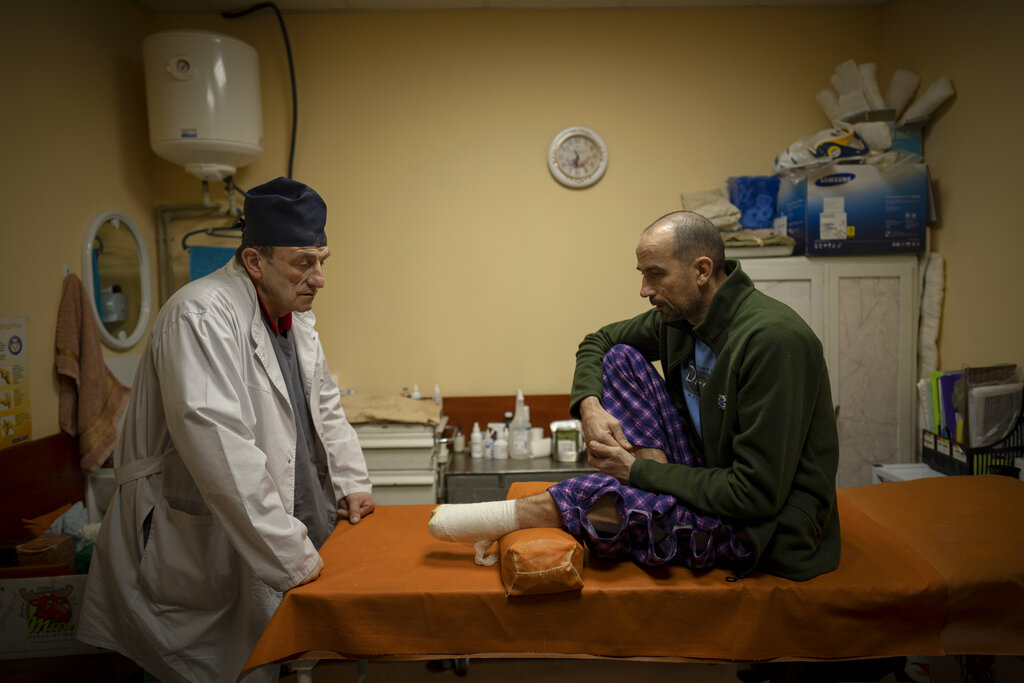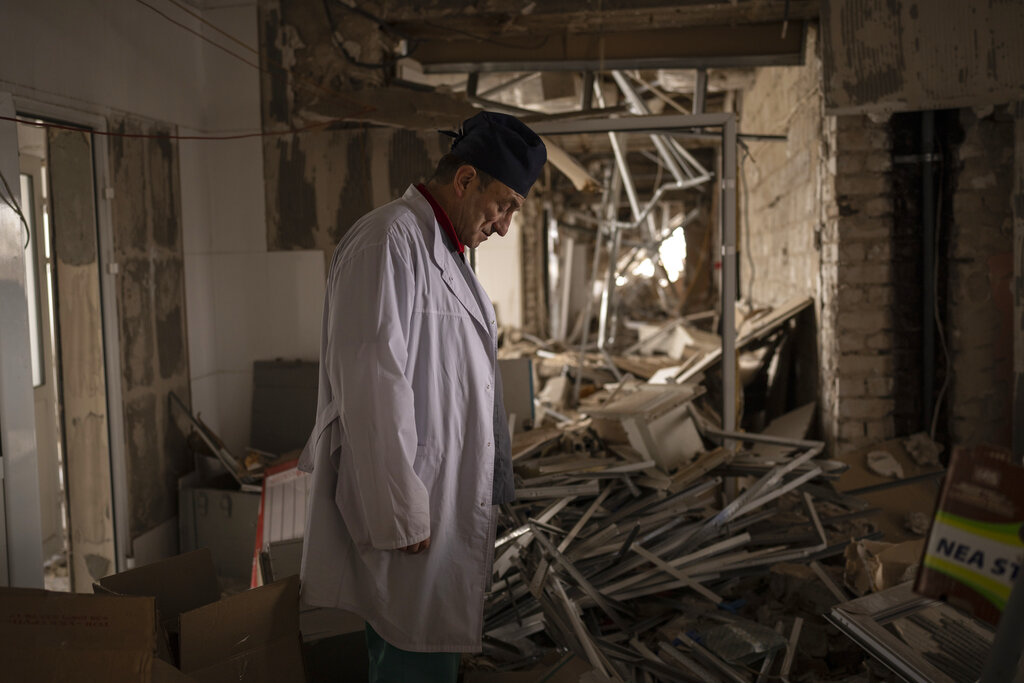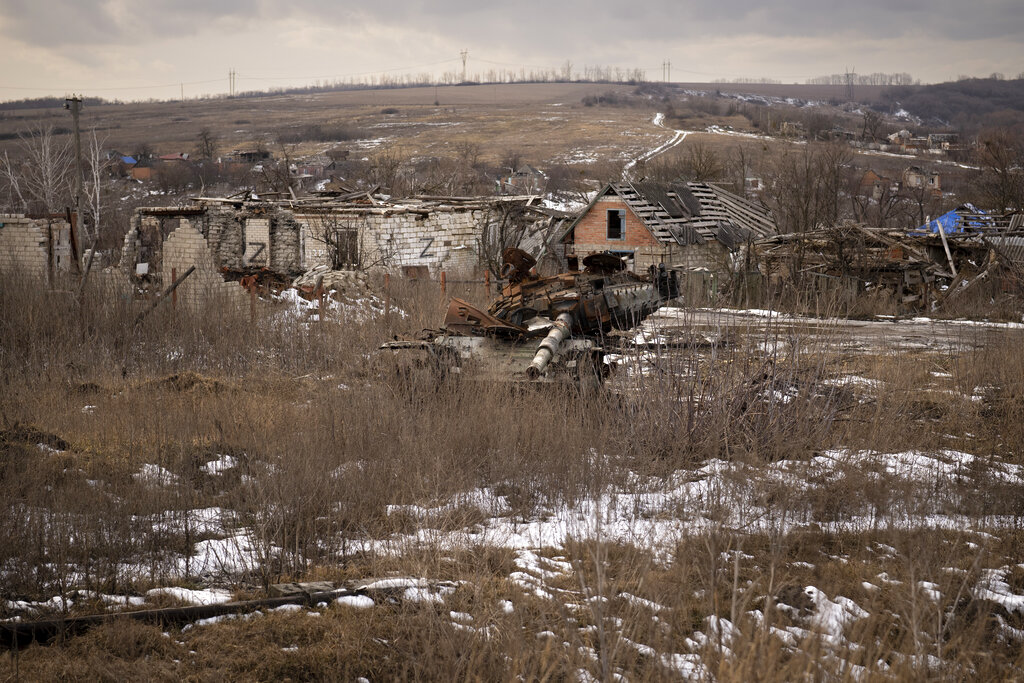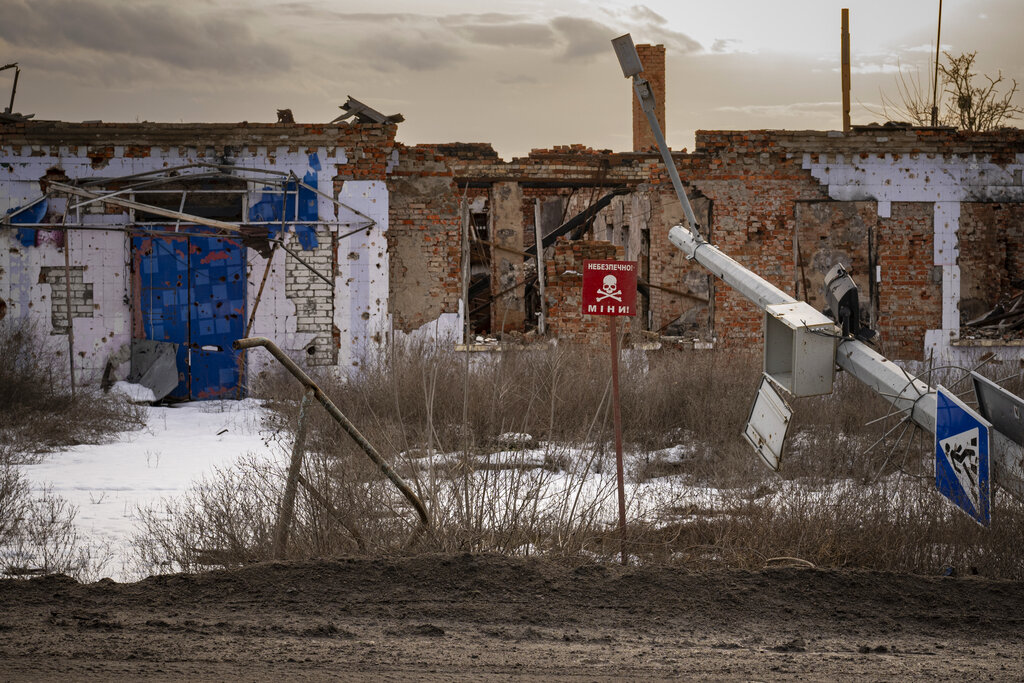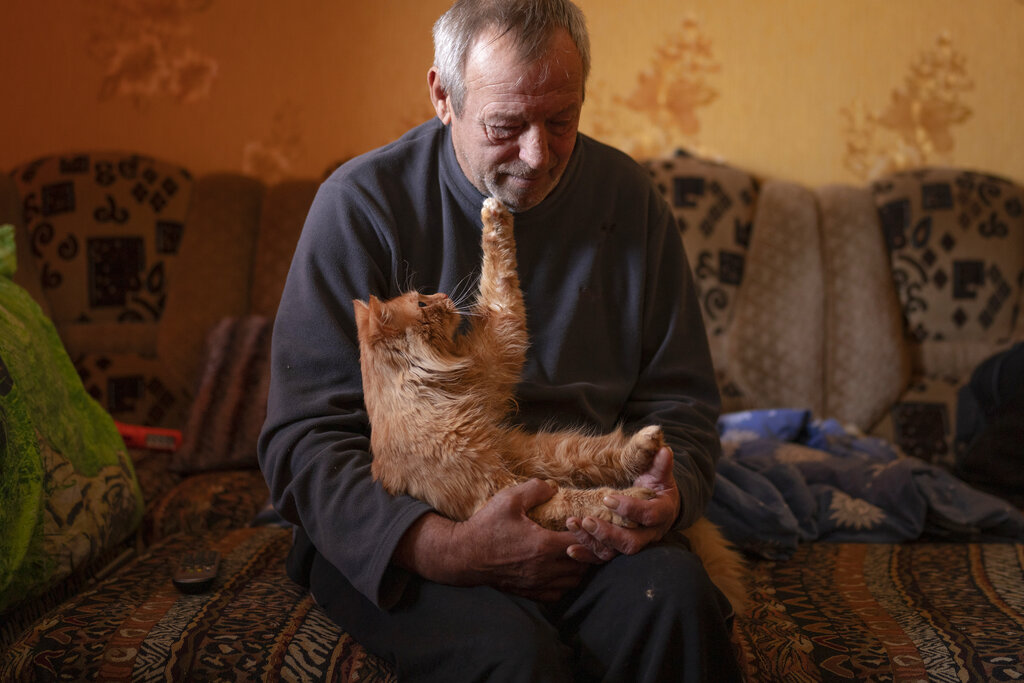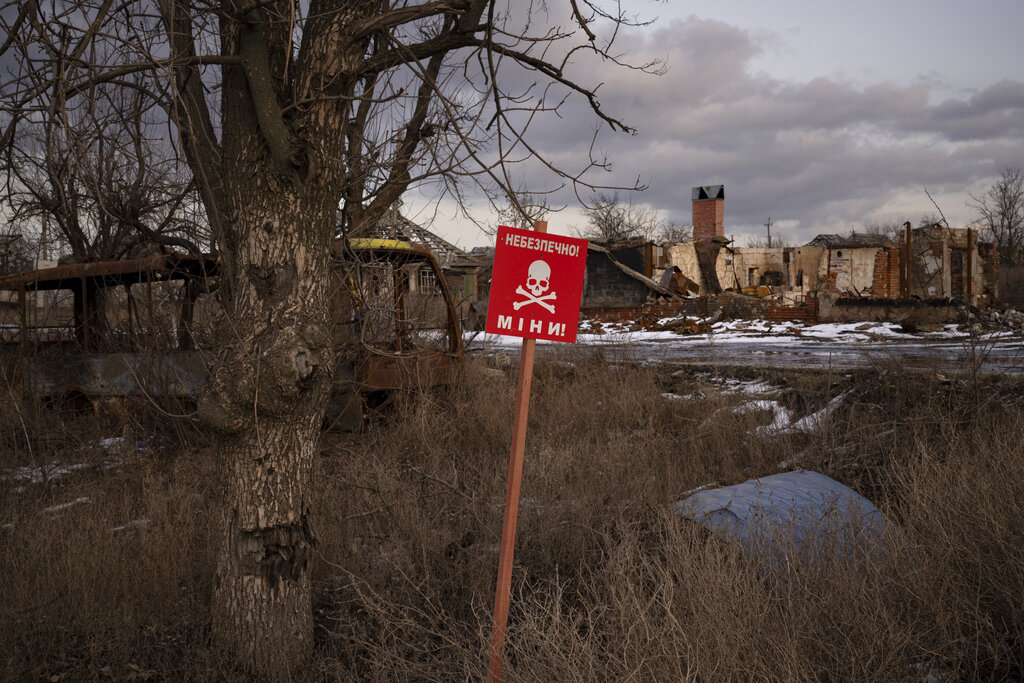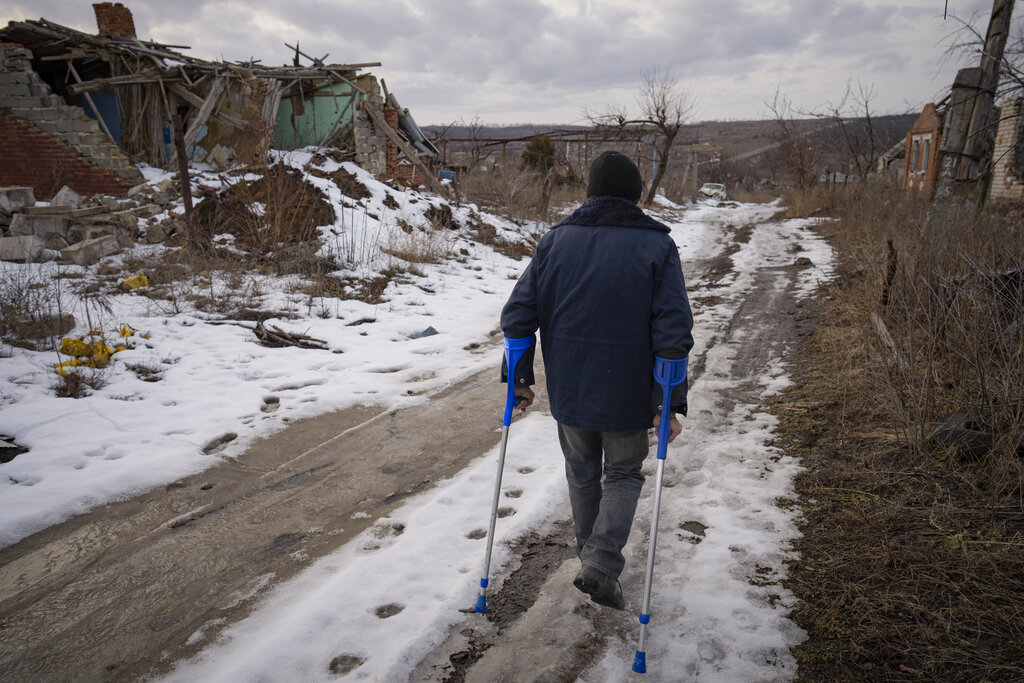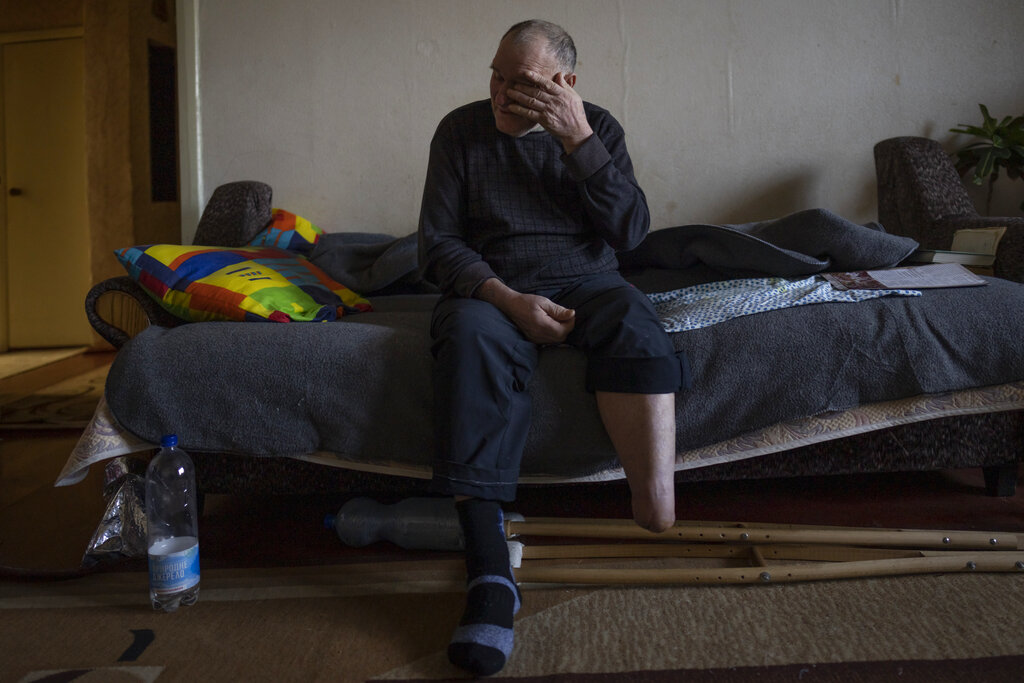In liberated Ukraine city, civilians still pay price of war

Land mine victim Oleksandr Rabenko, 66 years-old, speaks during an interview with the Associated Press as Murzik, his cat, approaches, at his son’s home on the outskirts of Izium, Ukraine, Sunday, Feb. 19, 2023. In this war-scarred city in Ukraine’s northeast, residents scrutinize every step for land mines. The brutality of the Russian invasion in this one-time strategic supply hub for Russian troops counts among the most horrific of the war, which entered its second year last month. (AP Photo/Vadim Ghirda)
IZIUM, Ukraine (AP) — In this war-scarred city in Ukraine’s northeast, residents scrutinize every step for land mines. Behind closed doors, survivors wait in agony for the bodies of loved ones to be identified. The hunt for collaborators of the not-so-long ago Russian occupation poisons tightly-knit communities.
This is life in Izium, a city on the Donets River in the Kharkiv region that was retaken by Ukrainian forces in September, but still suffers the legacy of six months of Russian occupation.
The brutality of the Russian invasion in this one-time strategic supply hub for Russian troops counts among the most horrific of the war, which entered its second year last month.
Ukrainian civilians were tortured, disappeared and were arbitrarily detained. Mass graves with hundreds of bodies have been discovered and entire neighborhoods were destroyed in the fighting.
Izium is a gruesome reminder of the human cost of the war. Six months after it was liberated, residents say they continue to pay the price.
Large red signs warning “MINES” rest against a tree between a church and the city’s main hospital, which is still functioning despite heavy Russian bombardment.
In this city, everyone has a mine story: Either they stepped on one and lost a limb or know someone who did. The mines are discovered daily, concealed along riverbanks, on roads, in fields, on the tops of roofs, in trees.
Of particular concern are anti-infantry high-explosive mines, known as petal mines. Small and inconspicuous, they are widespread in the city. Human Rights Watch has documented that Moscow has used at least eight types of anti-personnel mines, prohibited by the Geneva Conventions, throughout eastern Ukraine.
In a January report, the rights monitor also called on Kyiv to investigate the Ukrainian military’s apparent use of thousands of banned petal mines in Izium.
“No one can say now the total percentage of territory in Kharkiv that is mined,” said Oleksandr Filchakov, the region’s chief prosecutor. “We are finding them everywhere.”
Most residents are careful, keeping to known paths. But even then, they are not safe.
“We have an average of one person a week with wounds” from mines, Dr. Yurii Kuzentsov said. “I don’t know when I will ever go to the river or the forest again, even if our lives are restored, because, as a medical professional, I have seen the consequences.”
One patient stepped on mines twice: First in June when he lost part of his heel and the second time in October when he lost the entire foot.
Most of Kuzentsov’s patients said they had been cautious.
“They were sure this would never happen to them,” he said.
Oleksandr Rabenko, 66, stepped on a petal mine 200 meters from his house while walking down a familiar path to the river to fetch water.
His son, Eduard, had de-mined a narrow path with a shovel. Rabenko had walked down it several times, up until Dec. 4, when he lost his right foot while clearing some sticks.
“I still don’t know how it got there, maybe it was the snow melting, or the river carried it,” he said. “I thought it was safe.”
Rabenko still feels excruciating pain from the foot that is no longer there.
“The doctor said it will take months for my brain to grasp what happened,” he said.
Halyna Zhyharova, 71, knows exactly what happened to her family of eight.
A bomb struck her son Oleksandr’s home last March, killing 52 people sheltering inside the basement. They included eight of Zhyharova’s relatives — her son and his entire family, including two daughters.
Seven relatives’ bodies were exhumed in September in a severe state of decay. It took months to identify them, she said. Now she is waiting for just one more identification — of her granddaughter.
Of the 451 bodies exhumed in Izium, including nearly 440 found in mass graves, 125 have still not been identified, said Serhii Bolvinov, the head of the Investigations Department of Kharkiv’s National Police.
Some are so decomposed it’s difficult to extract a DNA sample, he said. Other times, authorities are unable to find a DNA match among relatives. The painstaking work can take months.
Zhyharova hopes her granddaughter’s remains will be identified soon so she can finally lay her family to rest.
“I’ll bury them, put gravestones,” she said. “After that, what to do? Live on.”
The scale of destruction in Izium, with a prewar population of 50,000, is breathtaking. Ukrainian officials estimate 70% to 80% of residential buildings were destroyed. Many bear black scorch marks, punctured roofs and have boarded-up windows.
Slowly, residents are returning, horrified to discover their homes uninhabitable or their possessions stolen. They seethe with anger, knowing the Russian advance into Izium was made possible by the help of local collaborators who supported Moscow.
“There were cases in the beginning of the war when collaborators led Russian armed forces units through secret routes and led them to the flanks and rears of our units,” said Brig. Gen. Dmytro Krasylnykov, commander of the joint forces in the Kharkiv region. “This happened in Izium.”
“Many of our soldiers died because of this, and we were forced to leave Izium for a while, and now we see what the city has turned into,” he said.
In the village of Kamyanka near Izium, every house bears the scars of war. Twenty families have returned and many have directed their venom at Vasily Hrushka, the one who remained. He has become the village pariah.
“They say I was a collaborator, a traitor,” the 65-year-old said. “I did nothing wrong.”
Hrushka says he stayed in the village while Russians overtook it, because he didn’t want to abandon his cows and three calves, fearing they would die in his absence. He sent his family away and took refuge in the cellar.
Russian soldiers knocked on the door, asked him if any Ukrainian servicemen lived in the house. When he replied no, they sprayed the place with bullets just to make sure.
Later, they came by with an offering of canned food. He gave them milk. Once they asked him if he had any alcohol.
Residents saw this as a sign of treason. They asked why he didn’t do more to help Ukrainian forces by finding a way to give away Russian positions. But Hrushka said there was no way to do that — the Russian soldiers destroyed his phone lines.
“I was living in madness,” he said, “I did what I did to survive.”
He was called in for questioning by the SBU, Ukraine’s security service. They said they heard rumors he was living the life of a chief in Kamyanka.
“I was the chief only of my own home,” he told them. They let him go.
In November, his fortunes took another turn.
Foraging for firewood as temperatures dropped, he stepped on a petal mine and lost his left foot.











